Persona 1 Casino Guide
Rating Summary This is a role-playing game (RPG) in which players assume the role of high school students that battle demons in their hometown. Players traverse through dungeons, negotiate with enemies, and enter turn-based battles with an assortment of demons, zombies, spirits, and slimes. After years of being asked to make a let's play Persona series I finally give in! I begin a blind let's play of Persona 5! I know almost nothing about this game other than the fact that we're. Whether you’re playing the original or Persona 5 Royal this walkthrough of Niijima’s Casino Palace will help you get through the entire dungeon, defeat its boss, and help you find the location. Rating Summary This is a role-playing game (RPG) in which players assume the role of high school students that battle demons in their hometown. Players traverse through dungeons, negotiate with enemies, and enter turn-based battles with an assortment of demons, zombies, spirits, and slimes. Persona doesn't speak much and wears a mask so much of their personality is rather obscure. In Episode 1, Persona first appears when the protagonist time travels back to the day of their final graduation exam. Upon meeting the protagonist and Afin, Persona attempts to attack the two but is stopped by Gettemhult.
- Persona 5 Strategy Guide
- Persona 1 Review
- Persona 1 Casino Guide Free
- Persona 1 Contact Guide
- Persona 1 Psp Guide
Our Beginner’s Guide series is designed to help those who are just starting to learn about user experience, or those who want to brush up on the basics. In this first part, we look personas.
What is a persona?
Simply put, a persona is a representation of a particular audience segment for a website / product / service you are designing, based on various types of qualitative and quantitative research. It captures a person’s motivations, frustrations and the “essence” of who they are.
Listen: Design Untangled Podcast – Persona or Personah?
Why do I need a persona?
Personas are based on real users. They help you understand who will actually be using your website, service or product and therefore can be used to make key design and functionality decisions during the UX process.
Personas are handy to pull out when you are trying to communicate what the user experience should be like to stakeholders, designers, developers and anyone else involved in the project.
They are also particularly useful in helping you create realistic user journeys, which we will cover in our next beginner’s guide.
They have fallen out of fashion somewhat recently, being replaced with more collaborate and Agile research approaches.
When should I create a persona?
Personas can be one of the main and first outputs from the initial discovery phase of a project. They are a great way to visualise all the user and audience data you have managed to gather.
How do I create a persona?
There are a number of different ways to create personas, and a lot of it depends on budget, type of project and the type of data you are able to collect. You can gather inputs in a variety of ways, the most common being:
- Speaking to your client – they will often have some information or insights about their audience in the form of marketing information, previous research and customer segmentation. However, take this with a grain of salt as their perceptions of who their audience are may not always match the reality.
- Speaking to users – The most valuable way of getting good qualitative data is to speak to the people who are likely to use it. This means you need a vague idea of the sorts of people you need to speak to.
- Other sources – Other inputs can be analytics, more traditional MOSAIC style profiling, social media interactions (a great way of seeing what type of people are interacting with brands) and anything else you can get your hands on. The more you can find out the richer and more valuable your personas will be.
What should a persona contain?
There is no set template as to what a persona should or shouldn’t contain. Where audience types differ only in subtle ways then you may need more attributes to capture the nuances of the different personas. However in more known problem spaces like e-commerce projects you can also get results by using personas based purely on goals such as browsing, or searching.
Typically you will want to capture any number of the following attributes:
- A person’s goals on your website / service / product
- A person’s motivations for using it
- A person’s current pain points or frustrations
- Some demographic data such as age/location/sex (if it materially affects their behaviour)
- A quote that captures their attitude in general, or towards the website / service / product
- A short bio about their background
- A person’s technical ability along with which devices they use and how often
- Other brands or websites they may like
- A picture that captures that particular persona. Try not to use stock photography as this makes it hard to think about the persona as a real life person and can be difficult in gaining credibility. Dating sites are a good place to start for images – although remember to ask for permission if needed!


This is by no means a complete list, and in the past I have used attributes such as emotional state, affluence and even their favourite food depending on the project! Your persona should aim to capture what you have learnt using as much real data as possible, in an easy to digest format.
Persona 5 Strategy Guide


Persona 1 Review
What does a persona look like?
Again there is no real set template, however in order to make sure the personas communicate their information quickly and clearly it is normally best to stick to a single page which can be easily stuck on the wall or shared with stakeholders.
The more wordy they become they less likely they are to be used.
What’s next?
Persona 1 Casino Guide Free
Personas give you a great start in understanding about who you are designing for. They are an important input into many other UX and project activities and can be referred back to at any stage in a project to make sure everyone keeps focus on the user.
Persona 1 Contact Guide
Read our next beginner’s guide where we cover user journeys, and how personas can be used to help create them.
Persona 1 Psp Guide
Is there anything else you would like to see in our guides to make them more useful? Let us know in the comments.